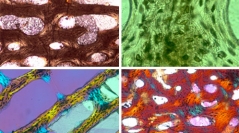

 Geodiversitas
40 (7) - Pages 161-170
Geodiversitas
40 (7) - Pages 161-170The first tuna-shaped amniotes evolved among ichthyosaurs, but this group exhibits in fact a wide diversity of morphologies and swimming modes. The histology and microanatomical features of vertebral centra of a diversity of ichthyosaur taxa from most basal to highly derived illustrating this variability were analyzed. The occurrence of unusual parallel fibered bone with platings of true parallel-fibered bone confirms high growth rate in all these taxa. Ichthyosaur vertebrae, which are deeply amphicoelous, show a limited endosteal territory associated with a limited growth in length. No bone mass increase nor decrease occurs. The vertebral centrum is spongious, and two microtypes are observed in the periosteal territory, with different degrees of organization of the trabecular network. The microtypes appear to be associated with the shape of the vertebral centrum, the organization of the spongiosa becoming homogeneous in the disk-shaped centra of cymbospondylids and Neoichthyosauria, rather than much more heterogeneous in spool-shaped centra of primitive Triassic forms. As opposed to what was previously suggested in other amniotes, the main switch in microanatomical organization appears thus to be correlated to the acquisition of deeply amphicoelous disk-like vertebral centra rather than to a shift in swimming mode from long and slender-bodied anguilliform swimmers to thunniform swimmers.
Ichthyosaur, vertebral centrum, histology, microanatomy, microtype, amphicoelous